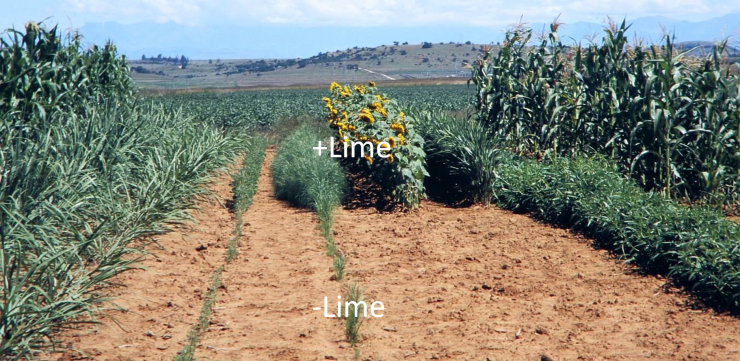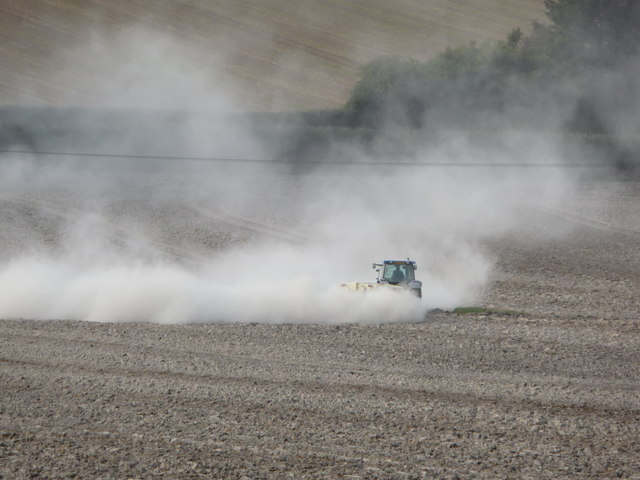Background:
Soil acidity is a challenge to soil health in agricultural systems, limiting yields due to low P availability and excess Al availability, particularly in humid subtropical and tropical climates. Acidification of soil occurs due to: 1) weathering of soil silicate minerals, leaching of base cations, and formation of iron and aluminum oxides 2) oxidation of native and applied carbon, sulfur, and nitrogen, 3) release of plant root exudates that include protons, organic acids and CO2,and 4) alternating wet-dry conditions that lead to proton generation by ferrolysis.1-4
Regardless of the cause, soil acidity may be corrected by applying acid-neutralizing materials such agricultural lime or dolomitic lime, usually in the form of ground limestone or dolomite. Quicklime (CaO) is rarely used because of it extreme alkalinity and reactivity. The biggest challenge in altering soil pH with liming agents is the large mass of liming material, on the order of tons per acre, often needed to correct soil acidity due to Al3+ hydrolysis. Acid neutralization with lime depends on several factors including: 1) liming material chemical composition, 2) lime particle size, 3) application mass, and 4) depth of incorporation into the soil.5-7

Effect of 10 tons/ha of lime on crop growth. https://commons.wikimedia.org/wiki/File:Crops_in_acid_soil_demo_2017_05_09_6748i.jpg By Alandmanson [CC BY-SA 4.0 (https://creativecommons.org/licenses/by-sa/4.0)], from Wikimedia Commons
Diagnosis:
Soil acidity is best diagnosed by soil testing; low cost testing may be done in the field using paper pH strips.
Management:
Below is a short summary of various considerations for using lime to correct soil acidity.
Lime application
Large amounts of lime are often needed to change the soil pH; simple soil tests can be used to determine soil pH and application amount.
- Soil testing is important before applying lime
- Application amount is determined by soil test results
- As soil pH doesn’t change immediately after applying lime, application timing is an important consideration.
Liming material chemical composition
Liming material alkalinity is dependent on the chemical composition of the material being used.
- Different types of lime have different acid neutralizing power
- Alternatives to lime include alkaline stabilized biosolids.
Liming material particle size
Small particles of lime dissolve faster than larger particles, more rapidly changing soil pH.5 6
- Lime formulation and particle size are important to consider prior to application.
Lime material incorporation
Incorporation reduces diffusional distances required to neutralize soil acidity and neutralizes soil acidity in the most important area, the root zone.
- Lime placement is important to consider, especially in no till systems.
- Lime incorporation increases the rate with which soil acidity is neutralized.

Farmer applying lime: http://www.geograph.org.uk/photo/3143774 © Copyright Jeremy Bolwell and licensed for reuse under this Creative Commons Licence.
Additional Resources:
More information about soil testing and liming materials:
- A guide for educators designed to teach methods for testing soil acidity developed by the USDA. https://www.nrcs.usda.gov/Internet/FSE_DOCUMENTS/nrcs142p2_051574.pdf
- A extension publication from Virginia Tech on sources of lime for acid soils. https://pubs.ext.vt.edu/content/dam/pubs_ext_vt_edu/452/452-510/452-510_pdf.pdf
- Information on liming developed by the Virginia Department of Conservation and Recreation. http://www.dcr.virginia.gov/document/standardsandcriteria.pdf
- A presentation developed by University of Wisconsin-Madison on liming terminology and analysis. http://www.soils.wisc.edu/extension/materials/Liming_Terms.pdf.
More information about integrating liming into crop production:
- A UN FAO bulletin on efficient fertilizer use in acid upland soils of the humid tropics; contains information on liming. http://www.fao.org/docrep/018/aq356e/aq356e.pdf.
- A book chapter developed by William Natale, Danilo Eduardo Rozane, Serge-EÌtienne Parent and LeÌon Etienne Parent on soil acidity and liming in tropical fruit orchards. http://cdn.intechopen.com/pdfs/41133/InTech-Soil_acidity_and_liming_in_tropical_fruit_orchards.pdf
- A working paper developed by CIMMYT about remediating soil acidity with lime in Zimbabwe https://repository.cimmyt.org/xmlui/bitstream/handle/10883/3647/68620.pdf?sequence=1&isAllowed=y
- A leaflet on Acid soils and poor phosphorus availability by the Department of Agriculture for New South Wales. https://www.dpi.nsw.gov.au/__data/assets/pdf_file/0010/166384/nt-phosphorus-acidity.pdf.
- A UNFAO/IAEA document on the management and conservation of tropical acid soils for sustainable crop production. https://www-pub.iaea.org/MTCD/publications/PDF/te_1159_prn.pdf.
- A fact sheet developed by the Department of Primary Industries of New South Wales about soil acidity and liming in Australia. https://www.dpi.nsw.gov.au/__data/assets/pdf_file/0007/167209/soil-acidity-liming.pdf.
References:
- Buol, S. W.; Southard, R. J.; Graham, R. C.; McDaniel, P. A., Soil genesis and classification. John Wiley & Sons: 2011.
- Brinkman, R., Ferrolysis, a hydromorphic soil forming process. Geoderma 1970, 3 (3), 199-206.
- Bolan, N.; Hedley, M.; White, R., Processes of soil acidification during nitrogen cycling with emphasis on legume based pastures. Plant and soil 1991, 134 (1), 53-63.
- Fujii, K.; Funakawa, S.; Hayakawa, C.; Kosaki, T., Contribution of different proton sources to pedogenetic soil acidification in forested ecosystems in Japan. Geoderma 2008, 144 (3), 478-490.
- Laboski, C. Liming Terminology and Analysis. http://www.soils.wisc.edu/extension/materials/Liming_Terms.pdf (accessed 8/12).
- Mullins, G. L.; Alley, M. M.; Phillips, S. B., Sources of lime for acid soils in Virginia. 2005.
- Deenik, J. In Basic Concepts in Soil Fertility, Soil Fertility Workshop. February, 2005.
